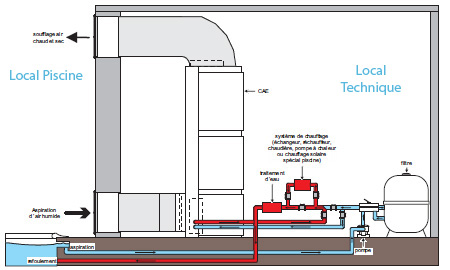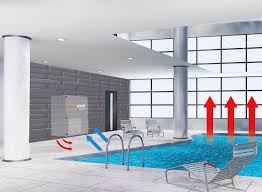
A condensation or ventilation dehumidifier?
Whether condensation or ventilation, the role of the dehumidifier remains the same: to combat and eliminate ambient condensation in order to sanitize the bathroom to satisfy bathers and ensure the longevity of the building. Both are autonomous equipment, the operation is distinct, the great disparity lies in the air renewal of the room. What are their differences? Which one to choose for your indoor swimming pool? What types of dehumidifiers for swimming pools are possible?
What is a ventilation dehumidifier?

The ventilation dehumidifier is bulky. This is why it is installed in an adjoining room so it is invisible and generates less noise in the pool room. The room where the dehumidifier is located must not only be adjacent to the pool room, but it must also be close to a wall that faces the outside.
How does the ventilation dehumidifier work?
On the one hand, the dehumidifier, thanks to a fan, sucks hot and humid air from the pool room and simultaneously, it sucks dry air from outside. The air from the pool is directed to the heat recovery box where there is a plate exchanger. Then, it is in the mixing box that the energy of the humid and warm air of the swimming pool transmits its heat to the dry outside air. Once the process is completed, dry, warm air is expelled into the pool room. Some models can benefit from a heat pump option, which allows the air to be heated more efficiently during the cold season.
The ventilation dehumidifier is capable of renewing up to 100% the ambient air of the water room.
The advantages and disadvantages of the ventilation dehumidifier
The ventilation dehumidifier allows optimal regulation of the temperature and humidity of the room. It uses air coming from outside and it is possible to partially or totally renew the air in the room.
As it is installed in an adjacent room, it is not done noise in the pool room and it is absolutely invisible. The atmosphere of the place is perfectly preserved.
This equipment cannot be used if the outside air is more humid than that of the pool room.
It is larger and more expensive to purchase than the condensation dehumidifier.
Its installation is often carried out by a professional, which causes an additional cost.
What is condensation dehumidifier?

It is the most commonly used device for swimming pool parts. It comes in the form of a console to be installed in the bathroom or it is built-in, and in this case, only the suction and blowing grilles are visible. Both can be installed by oneself, notably the room dehumidifier.
How does the condensation dehumidifier work?
The ambient air in the room is sucked in by a fan directed towards the evaporator which, thanks to the refrigerant at low temperature and pressure, brings the air to its dew point. The humidity contained in the air is transformed into water and is stored in a tank or evacuated into the wastewater circuit of the home. The now dry air continues its circuit, is heated by a process involving the condenser, the compressor and the refrigerant then it is returned to the pool hall. It is a closed circuit, only, certain models can possibly bring up to 30% fresh air from the outside.
The advantages and disadvantages of the condensation dehumidifier
When it is built-in, it is almost invisible and very quiet but it is more expensive and its installation is more difficult.
The room dehumidifier must be judiciously placed to blend into the decor. It is easy to install and use. The investment is reasonable, at equal power it is the most affordable price of all dehumidifiers.
The air circulates in a closed circuit except for a few models.
When to choose ventilation or condensation dehumidifier?
For reasons of comfort and/or hygiene, the ventilation dehumidifier is the ideal solution. It is installed in rooms where the volumes of air to be treated are very large, most often in public swimming pools, places requiring a high degree of comfort such as luxury hotels…
But, in the In the majority of cases, the condensation dehumidifier is chosen. It is powerful enough to effectively deal with condensation in private swimming pool halls with a smaller surface area and volume. In addition, the investment is less important than the ventilation dehumidifier for remarkable efficiency in the conditions stated.
A study makes it possible to define the real needs in terms of dehumidification of the indoor swimming pool, and makes it possible to determine precisely which device is best suited to the situation and the often unique characteristics of each pool room.
To find out which type of dehumidifier is best suited to your indoor swimming pool installation, discover the differences between the floor-standing or wall-mounted dehumidifier and the built-in swimming pool dehumidifier.